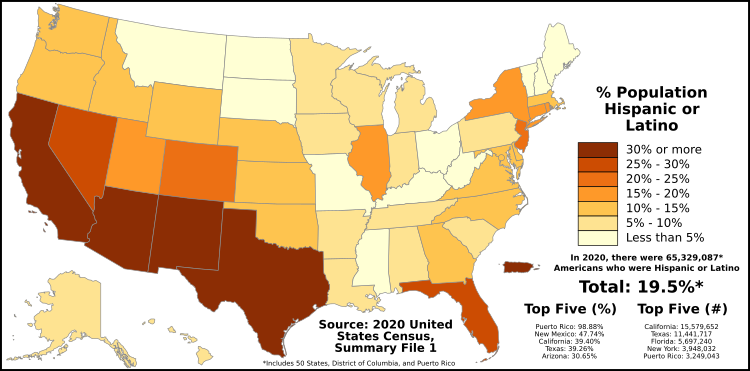Demographics of Hispanic and Latino Americans facts for kids

The demographics of Hispanic and Latino Americans depict a population that is the second-largest ethnic group in the United States, 62 million people or 18.7% of the national population.
The Latino population is much younger than the rest of the country, of no less than two dozen national origins and of every race, with a longer life expectancy than their fellow Americans, and geographically concentrated in the southwestern United States.
Contents
History
Hispanic and Latino Americans (along with Asian Americans, most notably) have contributed to an important demographic change in the United States since the 1960s whereby minority groups now compose one-third of the population. Nearly one in six Americans was Hispanic or Latino as of 2009, a total of 48.4 million out of the estimated 307 million Americans. High rates of immigration and fertility have shaped the growth of the Hispanic and Latino population.
Population
Hispanic and Latino Population by state or territory (2000–2010)
In 2011, Hispanics accounted for 16.7% of the national population, or around 52 million people. The Hispanic growth rate over the April 1, 2000 to July 1, 2007 period was 28.7%—about four times the rate of the nation's total population (at 7.2%). The growth rate from July 1, 2005 to July 1, 2006 alone was 3.4%—about three and a half times the rate of the nation's total population (at 1.0%). Based on the 2010 census, Hispanics are now the largest minority group in 191 out of 366 metropolitan areas in the US. The projected Hispanic population of the United States for July 1, 2050 is 132.8 million people, or 30.2% of the nation's total projected population on that date.
Geographic distribution
As of 2000, the ten most populous places with Hispanic majorities were
- East Los Angeles (97% Hispanic),
- Laredo, Texas (94%),
- Brownsville, Texas (91%)
- Hialeah, Florida (90%),
- McAllen, Texas (80%),
- El Paso, Texas (77%),
- Santa Ana, California (76%),
- El Monte, California (72%)
- Oxnard, California (66%),
- Miami, Florida (66%).
The Hispanic population of Los Angeles County, California, numbering 4.7 million, is the largest of all counties in the nation, comprising 47 percent of the county's ten million residents.
Race
Historically, over half of the Hispanic and Latino American population self-identifies as White. The largest number of White Hispanics come from within the Mexican community, the highest percentage of White Hispanics among major Hispanic groups comes from the Cuban American community, also high percentages of White Hispanics from Hispanic groups come from within the Colombian and also Spanish communities. The largest number of Black Hispanics come from within the Puerto Rican community, while the highest percentage of Black Hispanics among major Hispanic groups come from the Dominican community. Significant numbers of Black Hispanics can also be found among the Central American communities.
The largest number of Asian Hispanics come from within the Mexican community, while the highest percentage of Asian Hispanics come from the Peruvian community. The largest population of Native American Hispanic come from within the Mexican community and the highest percentage of Native American Hispanics among major Hispanic groups come from within the Guatemalan community.
Though comprising very small percentages of the Hispanic and Latino American population, and even smaller percentages of the total U.S. population, some of the preceding racial subgroups make up large minorities among the respective racial groups, overall. For instance, Hispanics and Latinos who are American Indian or Alaska Native compose 15% of all American Indians and Alaska Natives (per the ACS estimates). Meanwhile, the 120,000 Hispanics and Latinos who are of Native Hawaiian and Other Pacific Islander race compose 22% of this entire race nationally (per the Population Estimates). Again, nearly a third of the overall 'Two or more race' population is Hispanic or Latino (ACS).
See also
 In Spanish: Hispanización de Estados Unidos para niños
In Spanish: Hispanización de Estados Unidos para niños
- Demographics of the United States



